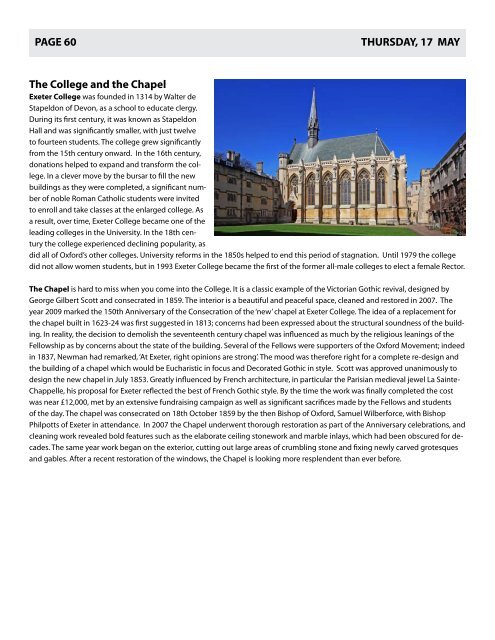Pipe Organs of England - Pipedreams - American Public Media
Pipe Organs of England - Pipedreams - American Public Media
Pipe Organs of England - Pipedreams - American Public Media
You also want an ePaper? Increase the reach of your titles
YUMPU automatically turns print PDFs into web optimized ePapers that Google loves.
PAGE 60THURSDAY, 17 MAYThe College and the ChapelExeter College was founded in 1314 by Walter deStapeldon <strong>of</strong> Devon, as a school to educate clergy.During its first century, it was known as StapeldonHall and was significantly smaller, with just twelveto fourteen students. The college grew significantlyfrom the 15th century onward. In the 16th century,donations helped to expand and transform the college.In a clever move by the bursar to fill the newbuildings as they were completed, a significant number<strong>of</strong> noble Roman Catholic students were invitedto enroll and take classes at the enlarged college. Asa result, over time, Exeter College became one <strong>of</strong> theleading colleges in the University. In the 18th centurythe college experienced declining popularity, asdid all <strong>of</strong> Oxford’s other colleges. University reforms in the 1850s helped to end this period <strong>of</strong> stagnation. Until 1979 the collegedid not allow women students, but in 1993 Exeter College became the first <strong>of</strong> the former all-male colleges to elect a female Rector.The Chapel is hard to miss when you come into the College. It is a classic example <strong>of</strong> the Victorian Gothic revival, designed byGeorge Gilbert Scott and consecrated in 1859. The interior is a beautiful and peaceful space, cleaned and restored in 2007. Theyear 2009 marked the 150th Anniversary <strong>of</strong> the Consecration <strong>of</strong> the ‘new’ chapel at Exeter College. The idea <strong>of</strong> a replacement forthe chapel built in 1623-24 was first suggested in 1813; concerns had been expressed about the structural soundness <strong>of</strong> the building.In reality, the decision to demolish the seventeenth century chapel was influenced as much by the religious leanings <strong>of</strong> theFellowship as by concerns about the state <strong>of</strong> the building. Several <strong>of</strong> the Fellows were supporters <strong>of</strong> the Oxford Movement; indeedin 1837, Newman had remarked, ‘At Exeter, right opinions are strong’. The mood was therefore right for a complete re-design andthe building <strong>of</strong> a chapel which would be Eucharistic in focus and Decorated Gothic in style. Scott was approved unanimously todesign the new chapel in July 1853. Greatly influenced by French architecture, in particular the Parisian medieval jewel La Sainte-Chappelle, his proposal for Exeter reflected the best <strong>of</strong> French Gothic style. By the time the work was finally completed the costwas near £12,000, met by an extensive fundraising campaign as well as significant sacrifices made by the Fellows and students<strong>of</strong> the day. The chapel was consecrated on 18th October 1859 by the then Bishop <strong>of</strong> Oxford, Samuel Wilberforce, with BishopPhilpotts <strong>of</strong> Exeter in attendance. In 2007 the Chapel underwent thorough restoration as part <strong>of</strong> the Anniversary celebrations, andcleaning work revealed bold features such as the elaborate ceiling stonework and marble inlays, which had been obscured for decades.The same year work began on the exterior, cutting out large areas <strong>of</strong> crumbling stone and fixing newly carved grotesquesand gables. After a recent restoration <strong>of</strong> the windows, the Chapel is looking more resplendent than ever before.


